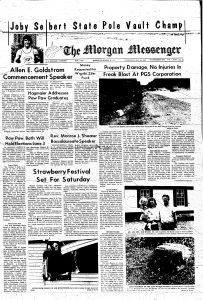U.S. Silica’s announcement that it is planning to move its blasting operations closer to Berkeley Springs — across the street from more than 60 homes — has triggered legitimate concerns among residents.

What impact will it have on the springs?
Is tearing down a mountain so close to a historic town a good idea?
How will the blasting affect air quality in town?
And is there a safety concern to nearby residents?
In a letter to local residents, U.S. Silica Berkeley Springs plant manager Pete Graham offered to survey residents’ property ahead of the move so that “should any changes be produced by the blasting operations — and we certainly do not anticipate that this will occur — they will then be documented.”
Of course, “changes produced by the blasting operations,” as Graham puts it, are not unheard of at the mine.
In May 1975, blasting at the mine — then owned by Pennsylvania Glass Corporation (PGS) — damaged nearby homes.
“Property Damage, No Injuries in Freak Blast at PGS Corporation” was the headline in the Morgan Messenger on May 28, 1975.
The paper reported that “a blasting operation on the property of PGS Corporation at approximately 11 am on May 23 went awry when a soft seam in the otherwise solid rock face which was being detonated gave way spewing stone fragments over an area of up to one half mile.”
“The impact was most significant in the area of Jimtown in Berkeley Springs, where at least a half dozen residential properties suffered damages ranging from minor to extensive,” the Messenger reported.
The paper reported that the force of the blast “was evident from the size of the larger rock missiles, the wide area over which the fragments were dispersed, and the distance traveled from the blast site by one of the largest chunks, the weight of which was estimated at a half ton and which landed nearly half a mile away” from the blast site.
According to the report, “heaviest property damages were inflicted upon the homes of Emery Metz, Sam Moore and Mrs. Arizona Henry, located respectively at 1102, 1014 and 1002 James Street.”
“At the Metz property, one missile went through the roof and front wall of a storage building across the street from the home,” the paper reported. “Another came through the roof of the house, tore through a bedroom at the head of the stairway and then outside through the paneled walls.”
The Sam Moore house “received extensive damage when a rock weighing well over 500 pounds crashed through the aluminum siding and wall at the corner of the living room and landed in the dining room,” the paper reported.
“Mrs. Moore, who was sitting by a small table with her young daughter, hurriedly ran to the kitchen area with the child when she felt the first shock of the blast,” the paper reported.
The rock came to rest “almost at the spot the two people had been sitting.”
Another large rock just missed the corner of the Henry household, “struck the ground, tearing up a large section of the Henry garden before shattering a retaining wall, which then exploded through the kitchen wall, completely demolishing the interior.”
“Some of the flying fragments sprayed through the porch area, causing minor abrasions on the legs of one of the children, but otherwise, no injuries,” the paper reported.
PGS President Hale E. Andrews released a statement to the press.
“The incident was caused by a freak occurrence, where the pressures are relieved by yielding rock in soft seams or fractured areas,” Andrews said. “The result is a blowout, which throws usually small quantities of broken rock a variable distance.”
“PGS is conducting an intensive examination of mining and blasting methods. The community can be assured that every precaution will be taken to restructure mining activity in the area in a manner which will safeguard against a similar occurrence.”
